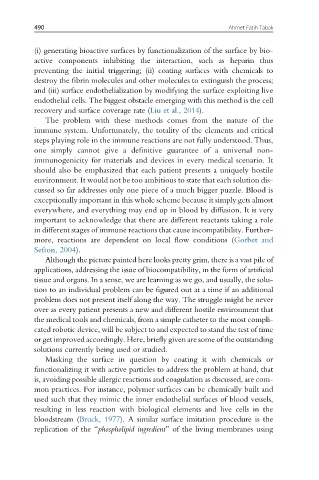Page 496 - Handbook of Biomechatronics
P. 496
490 Ahmet Fatih Tabak
(i) generating bioactive surfaces by functionalization of the surface by bio-
active components inhibiting the interaction, such as heparin thus
preventing the initial triggering; (ii) coating surfaces with chemicals to
destroy the fibrin molecules and other molecules to extinguish the process;
and (iii) surface endothelialization by modifying the surface exploiting live
endothelial cells. The biggest obstacle emerging with this method is the cell
recovery and surface coverage rate (Liu et al., 2014).
The problem with these methods comes from the nature of the
immune system. Unfortunately, the totality of the elements and critical
steps playing role in the immune reactions are not fully understood. Thus,
onesimplycannotgiveadefinitiveguaranteeofauniversalnon-
immunogenicity for materials and devices in every medical scenario. It
should also be emphasized that each patient presents a uniquely hostile
environment. It would not be too ambitious to state that each solution dis-
cussed so far addresses only one piece of a much bigger puzzle. Blood is
exceptionally important in this whole scheme because it simply gets almost
everywhere, and everything may end up in blood by diffusion. It is very
important to acknowledge that there are different reactants taking a role
in different stages of immune reactions that cause incompatibility. Further-
more, reactions are dependent on local flow conditions (Gorbet and
Sefton, 2004).
Although the picture painted here looks pretty grim, there is a vast pile of
applications, addressing the issue of biocompatibility, in the form of artificial
tissue and organs. In a sense, we are learning as we go, and usually, the solu-
tion to an individual problem can be figured out at a time if an additional
problem does not present itself along the way. The struggle might be never
over as every patient presents a new and different hostile environment that
the medical tools and chemicals, from a simple catheter to the most compli-
cated robotic device, will be subject to and expected to stand the test of time
or get improved accordingly. Here, briefly given are some of the outstanding
solutions currently being used or studied.
Masking the surface in question by coating it with chemicals or
functionalizing it with active particles to address the problem at hand, that
is, avoiding possible allergic reactions and coagulation as discussed, are com-
mon practices. For instance, polymer surfaces can be chemically built and
used such that they mimic the inner endothelial surfaces of blood vessels,
resulting in less reaction with biological elements and live cells in the
bloodstream (Bruck, 1977). A similar surface imitation procedure is the
replication of the “phospholipid ingredient” of the living membranes using

